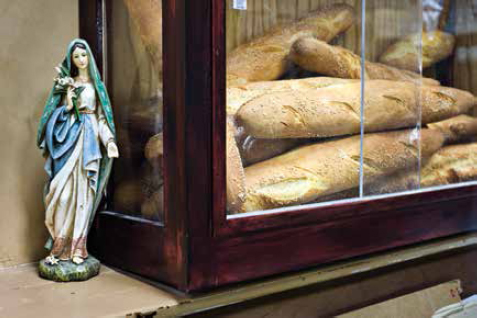The Feast of San Gennaro, still celebrated in Little Italies today, began in Naples in the seventeenth century.
The Feast of San Gennaro, still celebrated in Little Italies today, began in Naples in the seventeenth century.
If religious devotion is expressed through the prism of cultural tradition, then the more austere Irish- and German-Americans, settling in America decades before the Italians, were unprepared for, and simply mortified by, the ways in which this new ethnic group worshipped. The Italians’ public displays of faith—communal, baroque, and operatic—evoked as much exoticism and strangeness as Rudolph Valentino portraying a turban-wrapped Arabian prince. Rather than Roman Catholicism providing a haven for the new immigrants and a point of commonality with others who shared the faith, their unorthodox practices made it clear that religion would become another source of conflict.
The American Catholic Church, dominated by an Irish hierarchy, held a rigid set of rules. Being Catholic meant attending sullen and subdued masses each week, officiated by a priest who was the sole intermediary between the people and the divine. The Irish Catholic Church announced its presence and its power early in America; by 1879, the huge and ornate St. Patrick’s Cathedral stood in New York City as testament to the scale of the faithful’s devotion.
The Italians, for the most part, did not regularly attend weekly mass in southern Italy. They held a good deal of anticlerical attitudes because village priests usually sided on behalf of the landed gentry and many were corrupt. Church attendance had been reserved mainly for baptisms, communions, weddings, and funerals, the symbolic markers of the life cycle to which the Italians paid due reverence. When Italians did show up in church, they were not quietly pious but boisterous, or, in the case of funerals, screamed, pounded their breasts, pulled out their hair, and even hired mourners to wail along with them.
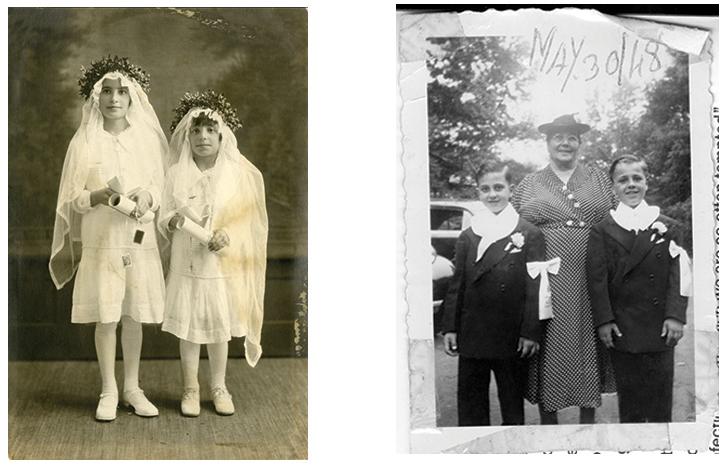
Receiving the sacrament of First Communion was an important ritual of Italian-American religious devotion.
Italians were most comfortable professing their faith in the streets. Southern Italians spent a great deal of time outdoors, and the peasants brought their faith to public spaces, routinely holding processions, or feste (“feasts”), to honor saints on their name days and to venerate the Madonna. Many needed to be honored—there were over one hundred patron saints, with some performing miracles and being worshipped in more than one town—and the contadini lovingly carried them through their villages.
When the Italians brought these rituals to the New World, the Irish Catholic Church did not know what to make of them. An earthy physicality defined the Italians’ worship, literally and metaphorically, in the bend of the penitents’ bodies and their depiction of saints. The hierarchy had never seen women licking the stones of a church floor in sacrifice and prostrating themselves before a statue of the Madonna. Nor did they believe that street processions in which pilgrims carried larger-than-life statues—not to mention food stands selling fried dough, nougat, and pastries, and tables hosting gambling—were acceptable ways to honor the sacred.
Madonna! Who were these people? And what was going on with their saints?
The American Catholic Church found the vivid and gory depictions of saints appalling. The patron saint of the blind, Saint Lucy, appeared in paintings holding a platter of two eyeballs, their peering dark irises served like gothic hors d’oeuvres. Arrows pierced the body of the bloodied Saint Sebastian, a favorite of soldiers. The worship of San Gennaro, Neapolitans’ most important saint—whose feast day, September 19, is still widely celebrated today with street fairs in Italian-American neighborhoods—began after Vesuvius erupted in 1631. The bubbling lava killed three thousand people, and the next day, to soothe the chaos and fear, an archbishop brought out the congealed blood of San Gennaro. The blood, said to have been kept in the saint’s cathedral since the fourth century, liquefied before the faithful, and the miracle is still reenacted in Naples every September.
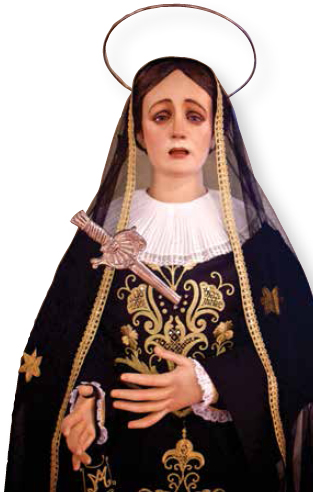
“Our Lady of Sorrows” expresses the devotion and pain of the Italian mother.
Southern Italians sought saints for miraculous interventions, not to provide moral guidance, which frustrated the Irish Catholic hierarchy. The Church also considered saints merely representations of the divine, not lifelike statues a hairbreadth from talking back. The Italians’ mystical bonds with their icons became a direct threat to the priest’s role as sole intermediary with the divine.
This intimate relationship was publicly celebrated and privately bartered. Italians believed that prayers provided a direct line to heaven, and they talked to, pleaded, fought with, and even dismissed saints in anger if prayers went unanswered. A nineteenth-century Neapolitan poem ’N paraviso (“In Paradise”) offers a glimpse into the Italian religious imagination. In this tale of unruly saints carping about heaven, the poet playfully suggests that even divine icons struggle with human foibles. They gossip (“Saint Clement is jealous of Saint Pascal”), argue, and whine. While the poem might undermine the idea of a glorious heaven, it also suggests that Italians see saints as family whose billowy breath feathers the cheeks of the faithful.
Only the Madonna, the poet concludes, is just and good, affirming the traditional Latin cult of the Virgin. The Italians brought their profound reverence for the Madonna, nostra mamma, to America, and they celebrated her in towns throughout the United States, in some places to this day. The celebration of the Madonna through the cult of Our Lady of Mount Carmel has existed since the seventeenth century, and in Roseto, Pennsylvania, she is revered in an annual procession called the “Big Time.” Every July the residents gather for this reunion and crown a local girl as queen. The largest of these early feast day celebrations took place on the streets of East Harlem, which by the 1920s attracted hundreds of thousands of Italians from along the East Coast.
The first East Harlem festa was held in 1882; the immigrants without their own church worshipped in a tenement courtyard ornamented only with a small painted picture of Our Lady of Mount Carmel, the patron saint of the town of Polla in the province of Salerno. Two years later, the Italians of East Harlem commissioned from Polla their own statue of the Madonna, which resembled a Mediterranean young woman and was graced with long, flowing locks of human hair. The East Harlemites adorned her gown with jewelry they donated, and she wore small pendant earrings, as might a young Italian woman. Eventually, they crowned her, the prized gold supplied from their savings.
After receiving their glorious Madonna, the Italians decided they needed a true brick-and-mortar church in which to worship her. So they built one, stone by stone, heading to a plot of land at 115th Street to throw down pickaxes after finishing a laborious day of work. Materials were carried in carts loaned by local icemen and junkmen, and by working continuously on the project—even women pitched in when a mason’s union objected to so many men working for free—construction was completed in the course of one year.
Although Italian labor built the church, the hierarchy refused to fully open its doors to the immigrants. The Irish clergy, still unsure of how to treat what they called the Italian “problem,” relegated parishioners to the basement to worship their Madonna from Polla. The clergy’s actions were mirrored in other communities in the United States, in which Italians worshipped in the back rows behind the more established Irish parishioners. The East Harlem Italians would remain in the basement until 1919, despite their anger and conviction that the clergy’s decision showed a profound disrespect to both them and the Madonna.
The Italians’ most important celebration of faith and culture remained on the streets during the July 16 festa for Our Lady of Mount Carmel. The weeklong event meant entertaining and housing out-of-town guests, preparing large meals of Italian specialties, and getting ready for the pilgrimage. The night before, they held vigils in the church; and on the day, family, friends, and devotees of the Madonna would come from all over the East Coast. Those from other boroughs in the city often walked barefoot for miles in the sweltering heat to make the pilgrimage to the Madonna. The statue from Polla remained in the church, taken out only on rare occasions, and a large replica was in procession through the streets.
The Italians believed that the Madonna would listen to their prayers and offer her benevolent healing powers. Those who sought a healing for physical ailments had large wax replicas of body parts and limbs molded for them to carry; others lifted huge candles in her honor. The weight of the candle was meant to match the gravity of the need, and some exceeded fifty pounds. Carrying hearts, legs, and arms, these grunting and sweating supplicants made their way through the thick summer air to light the wax body parts and candles in the church. One year, a sixty-nine-year-old man who had fallen unharmed from the fifth floor of a building thanked the Madonna by carrying, with the help of others, a 185-pound candle made to match his weight. Inside the church, several people would drag a woman along the church floor as she licked its stones before reaching the Madonna—a ritual that took place until it was stopped by the hierarchy in 1920.
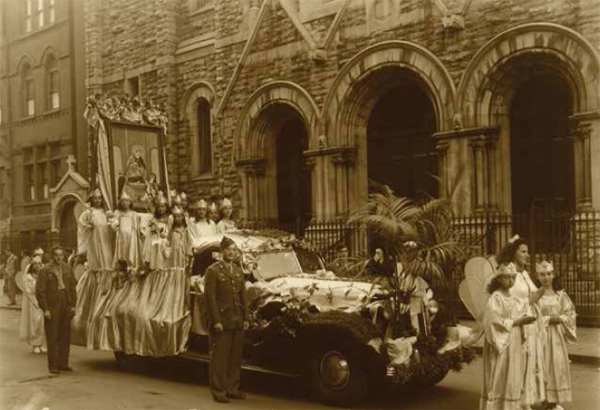
In America, Italians continued the practice of bringing their faith to public spaces, especially their devotion to the Madonna.
As the years went by, the celebration grew larger, attracting five hundred thousand by the 1930s, as did the spectacle in the streets. Thousands upon thousands marched, carrying votive candles in the night. Fireworks exploded, and the smells of sautéing sausages and crispy zeppole, fried dough sprinkled with sugar or honey, infused the thick summer air. There were games, rides, and gambling in a Fellini-like spectacle that, as the Irish clergy saw it, mixed the sacred and profane.
But for the Italians, while the festa offered gaiety, it was profoundly serious, their sacrifice announced by every blistered foot and pound of wax hefted and lit at the altar. They were worshipping their most revered figure, next to Jesus: the mother who protected them and their children, and who served as a purity figure for the girls. The women were the main standard bearers of this faith during the year, although the men participated in the annual celebration. Who better than she—they said of their Madonna, witness to and carrier of the world’s suffering—could understand the pain of their sacrifice and hardship in Italy and America?
She helped them as they adapted to a new land and culture, and she continued to respond to their needs as the decades marched on. During World War II, Italian mothers came to her, desperate for a sign that their sons would be safe. Those sons wore her image on scapulars as they entered battle, and the wounded would pray to her for healing. Families wrote petitions to the Madonna that were published in the parish’s newsletter.
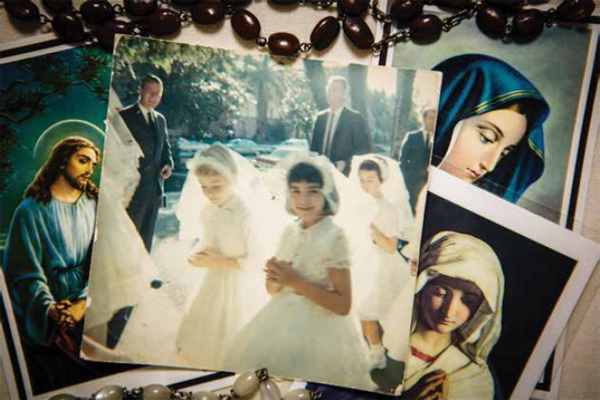
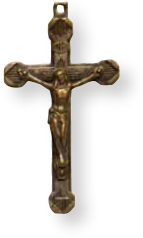
By the 1950s, the East Harlem community had begun to adopt more of the established structures of the American Catholic Church, hosting Holy Name Society and PTA meetings. They still celebrated the grand festa, but many social activities now took place inside the church and preoccupied them during the year. The power of the Madonna over the community began to wane by the 1960s and ’70s, as Italian Americans moved out of their urban apartments to buy homes in the suburbs. Yet often they would come back for the July celebration, thousands marching, both to proclaim the form of Catholicism Italians felt most comfortable practicing and to remember the East Harlem of their parents’ or grandparents’ youth. The festa became as much about memory and nostalgia—in its most traditional meaning of a longing for one’s former homeland—as a religious celebration.
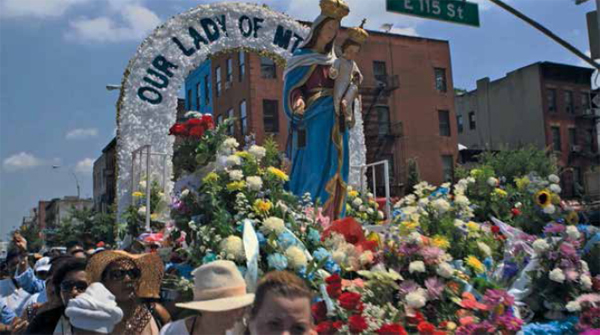
The devotion to Our Lady of Mount Carmel continues today.
Today, over 130 years later, the celebration continues, and families return to East Harlem to join a small Italian-American population. The majority of pilgrims who go to Our Lady of Mount Carmel for the annual festa are Haitian Americans. The Haitians share the same patron saint, adding the sounds of French Creole to the chants and susurrations. Inside the church, the Madonna from Polla presides on her altar, but the Haitians pray to another statue of the Madonna, whose skin coloring is a shade darker. Crowding their Madonna, they place petitions in her hands, along with small change, worshipping, like the Italian pilgrims before them, a spirit who listens quietly and takes heed of their suffering and sacrifices.
